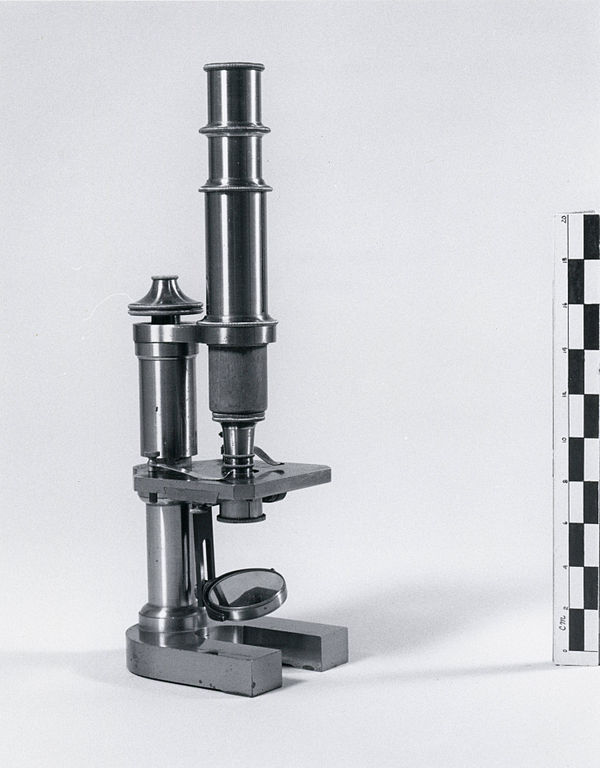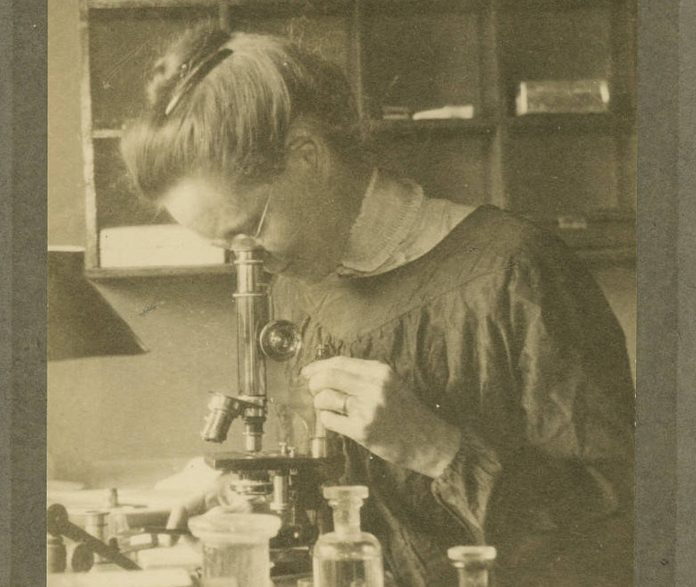At the time of her death in 1912, Nettie Maria Stevens was a biologist of enough repute to be eulogized in the journal Science by future Nobelist Thomas Hunt Morgan and for her passing to be noted in The New York Times. In 1910 she had been listed among 1,000 leading American “men of science.”
Yet in 1916, when Calvin Bridges published his proof that genes lie on chromosomes (the first paper in the first issue of GENETICS), Bridges cited the pioneering observations of a “Miss Stevens.” He also offered sincere thanks to “Dr. T.H. Morgan” and to his lab mates “Dr. A.H. Sturtevant and Dr. H.J. Muller.”
But “Miss Stevens” had in fact earned her PhD under Morgan’s supervision, just like Alfred Sturtevant, Hermann Muller, and Bridges himself. Why then did Bridges address the men as “Dr”, but granted Stevens only a “Miss”? The reason was likely convention. It seems to have been common in academic journals, including GENETICS, to refer to a woman with a PhD as “Miss” or “Mrs.” Indeed, Morgan’s obituary in Science is titled “The Scientific Work of Miss N.M. Stevens.”
In honor of Women’s History Month and the Centennial celebrations of GENETICS, Genes to Genomes takes a closer look at the “Miss Stevens” cited in the journal’s very first article.
Becoming a biologist
Before becoming a biologist, Stevens had been a teacher and occasional librarian for more than a decade. Her first career allowed her to save up for college; at the age of 35, she resigned from a high school teaching job in Massachusetts and traveled across the country to enroll at Stanford University in California.
At the time, Stanford was a five-year-old institution that was attracting many women interested in science majors. Stevens earned a baccalaureate degree, followed by a Master’s degree with research on the life cycle and microanatomy of ciliates. In 1900, the same year Mendel’s “laws of inheritance” were rediscovered, Stevens traveled back East to commence her PhD research at Bryn Mawr, a women’s college in Pennsylvania.
Stevens continued her ciliate work under embryologist and biology department head Morgan, who was impressed by her talent and independence (he was five years her junior). In 1901 Stevens was awarded a fellowship to study in Europe, where she worked with German zoologist Theodor Boveri. Around the time of Stevens’ visit, Boveri was conducting exciting experiments linking heredity to mysterious dark-staining entities in the cell nucleus known as chromosomes. Boveri’s work revealed that a complete set of chromosomes was needed for development to proceed normally, revealing that each chromosome maintained its own distinct identity.
Sex determination
After her European adventure, Stevens was eager to apply her impeccable histology skills to the hot topic of chromosomes and Mendelian inheritance. Once she graduated with her PhD in 1903, she and Morgan planned a collaboration on the controversial and unresolved question of how sex is determined in the developing egg. Did external factors, like food and temperature, set the sex of an egg? Or was it something inherent to the egg itself? Or was sex inherited as a Mendelian trait?
But by this time, Stevens was running out of savings. Without other means of support, she worried that her dreams of devoting herself to research would be buried in teaching duties. Morgan encouraged her to apply for a Carnegie Institution research fellowship and gave her an enthusiastic reference. Stevens was eventually awarded the fellowship and “freedom from anxiety over the money question.”
Part of the money was used for Stevens’ and Morgan’s collaborative work, in which they investigated the relation between sex determination and food source in aphids. But Stevens also pursued a side project on some alluring hints that sex was determined by inheritance of specific sets of chromosomes. In 1901, Clarence Erwin McClung had proposed that a peculiar chromosome in the insect Pyrrhocoris was responsible for determining its sex. At meiosis, this “accessory chromosome” was sorted into only one of the two sperm precursor cells.
Stevens examined a range of insect species in a hunt for other accessory chromosomes. When Stevens examined the meal worm Tenebrio melitor, she made a striking observation. This species produced two classes of sperm: a type that carried ten large chromosomes, and a type that carried nine large and one small chromosome. Body cells in the females contained 20 large chromosomes while males carried 19 large and one small chromosome. She reasoned that when an egg is fertilized by a sperm that carries the small chromosome, the result is a male offspring. The presence of the small chromosome might be what decided the individual’s “maleness.”
As is so often the case in science, one of Stevens’ colleagues discovered something similar at almost the same time. Prominent cell biologist Edmund Beecher Wilson made related observations of the behavior of an extra, unpaired chromosome in two hemipteran (bug) species.
But even combined with Wilson’s observations, it was not clear whether the pattern Stevens saw was just a quirk of an obscure species. The next important step, she concluded, was to examine a wider range of insects.
Stevens embarked on a painstaking survey that eventually covered 50 species of beetle and nine species of fly (including Drosophila melanogaster). Every species she examined had accessory chromosomes that either resembled Tenebrio (now known as an XY system) or they had an unpaired chromosome like Wilson’s bugs (now known as an X0 system). Clearly Tenebrio was no anomaly.
Sadly, Stevens never got to see final confirmation of her hypothesis. Though she continued pursuing evidence for several years, she died from breast cancer in 1912, at the age of 50.

Plate IV from Stevens (1905) showing hand-drawn micrographs from Tenebrio molitor samples.
American women of science
Morgan’s obituary for Stevens was ambivalent. He praised her “single-mindedness and devotion, combined with keen powers of observation; her thoughtfulness and patience, united to a well-balanced judgment.” Scientists had been slow to recognize the significance of her discovery, he said, because of their scientific conservatism. In almost the same breath, however, Morgan diminished Stevens by characterizing her as over-cautious and “at times wanting in that sort of inspiration that utilizes the plain fact of discovery for wider vision”. He portrayed her as a great technician but not a great theoretician.
Ironically, Morgan had been considerably more cautious than Stevens on the question of sex chromosomes. Indeed, his reference to “conservatism” in Stevens’ obituary may have been a subtle joke at his own expense, since he had only started to accept the evidence for sex chromosomes two years earlier. Some have also argued that Wilson was less willing than Stevens to embrace the Mendelian implications of the evidence. Either way, it would not be fair to characterize Stevens as over-cautious in her interpretations of sex chromosomes. The truth was, even though her observations were suggestive, she was right in concluding they fell short of proving that chromosomes determine sex. In 1908, she suggested the only hope of testing whether sex is indeed a Mendelian character must come from breeding experiments. Though she did not live to see it, she was correct. The matter was settled with Morgan’s own results mapping a Mendelian factor (the white eye mutation) to a sex chromosome in Drosophila.
In 1910, Stevens earned a coveted “star” next to her entry in “American Men of Science”, which meant she had been ranked among the top 1,000 scientists in the country. In a statistical analysis of this science elite, the directory’s publisher (who was also the editor of Science), noted that only 18 women ranked in the list, down from 19 women seven years earlier. He saw this as evidence that women were not as fit for the job as men:
“There are now nearly as many women as men who receive a college degree; they have on the average more leisure; there are four times as many women as men engaged in teaching. There does not appear to be any social prejudice against women engaging in scientific work, and it is difficult to avoid the conclusion that there is an innate sexual disqualification. Women seem not to have done appreciably better in this country than in other countries and periods in which their failure might be attributed to lack of opportunity. But it is possible that the lack of encouragement and sympathy is greater than appears on the surface, and that in the future women may be able to do their share for the advancement of science”
Today, the idea that women scientists in 1910 faced no social prejudice seems absurd. Nettie Stevens succeeded within a system that devalued her work. For example, the year she graduated from Stanford, the university’s co-founder Jane Stanford capped enrollment of women at 500 students, fearing her university was turning into a girls’ college. As a woman, Stevens could not have enrolled in graduate school at some of the most respected institutions in the country. Women were severely restricted in the types of academic jobs open to them. Women who did gain jobs in academia were expected (in some places legally compelled) to give up paid employment upon marriage.
Stevens lived in a world that assumed her inferiority and repeatedly emphasized that she was different from her male colleagues. Even in the dry pages of academic journals, her gender was appended, like an asterisk, to her name and accomplishments until long after her death.
Thanks to Casey Bergman for a Twitter conversation that prompted me to wonder about the use of “Miss Stevens” in Bridges’ 1916 paper.

Nettie Stevens’ microscope at Bryn Mawr College. This instrument was reserved for the use of advanced graduate students after Stevens’ death and was “much valued and treasured and affectionately known as the ‘Nettie Maria’.” (Ogilvie and Choquette 1981) Photo: Bryn Mawr College [CC BY-SA 3.0], via Wikimedia Commons































